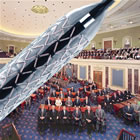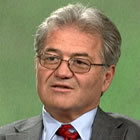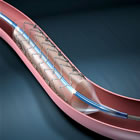![]()
<< To Homepage >>
<<Archives>>
December 2010 Archives:
December 10, 2010 -- 3:45pm EST Stent Accusations: The U.S. Senate Tries
to Drum Up COURAGE
Well that sort of indicts the entire world of interventional cardiology, doesn't it? (Not to mention that Senators seem to go for anything with the word "cocktail" in it.) This Senate report is saying that stents are basically useless! Just take your generic drugs and you'll be fine. Of course, unmentioned is that fact that the COURAGE study received considerable funding from Big Pharma. Also unmentioned is the fact that 1/3 of the COURAGE medicine-only cohort wound up switching over to stenting because their pain was not being relieved. For our analysis of COURAGE, read our article: "Don't Cancel Your Angioplasty or Heart Stent Yet, Say Patient Advocates." Back to my point: the Senate report quotes (above) a somewhat flawed Wall Street Journal article that appeared earlier this year, titled "A Simple Health-Care Fix Fizzles Out" -- you can read my way too lengthy critique of that article here: "Stents Downgraded by Wall Street Journal: If Only It Were That Simple ." COURAGE is actually a very important study and the real message is that it is okay to take a "wait and see" strategy when dealing with stable angina patients; that you are not endangering their lives by treating them with "optimal medical therapy" first. If they don't improve, you can always implant a stent at a later date. This was already the recommendation in the practice guidelines for stable angina -- and COURAGE gave this approach more weight. But the message was NOT that stents are unnecessary -- in fact, in the case of acute myocardial infarction (AMI), stents are considered to be the gold standard of care! Implanting a stent in a patient who is having a heart attack can actually stop the heart attack from progressing, saving heart muscle and preventing a life limited by heart failure. I discuss this in my blog post, "Heart Attack and Angioplasty: A Public Education Challenge" and I mention Dr. William O'Neill, who pioneered the use of angioplasty in cases of heart attack.
O'Neill went on to discuss where the real controversy is: cases where the blockages were in the area of "intermediate severity." On an angiogram, these blockages might look moderate or mild, but O'Neill said Midei had a clinical rationale for performing stenting on these patients. As I've written over the past few days, much of this controversy of whether or not these blockages were significant enough to stent, might have been resolved through the use of a new tool, called Fractional Flow Reserve (FFR). But FFR was not available at Midei's hospital (although he claims he had "pushed for it"); instead he had to rely on the patient's clinical symptoms and the X-ray video, called an angiogram. Dr. O'Neill also had comments on the accuracy of angiograms:
A final part of this story (and please forgive the length of this post -- but on Monday I did warn you...) -- the final part is the "involvement" of the stent manufacturer Abbott. There are a number of emails back and forth between Abbott executives and Dr. Midei. One from John Capek, who headed up Abbott's vascular division, congratulated Midei for having implanted a record 30 stents in one day. Another from Dave Pacitti, Abbott VP of Global Marketing was a bit rougher -- when Baltimore Sun business reporter Jay Hancock penned some of the initial accusations against Midei, Pacitti emailed a subordinate in Baltimore, "Someone needs to take this writer outside and kick his ass! Do I need to send in the Philly mob?" Ouch. And then there was the $2,000 smoked pig roast that Abbott provided for Midei and his cath lab staff (prices vary, depending on which newspaper you read). And finally, when Midei lost his privileges at St. Joe's, Abbott hired him on as a $30,000-plus consultant to teach others (here and abroad) about their new drug-eluting stent, the XIENCE V. The accusations against Abbott are that they were pushing the use and overuse of their stent -- that making money was all that mattered. And reading through the emails quoted in the Senate Report reveals an undeniable and appalling insensitivity, especially to anyone "outside" of the industry. Of course, no one at Abbott was thinking "outside" the industry; they were consumed by something else. Abbott's second generation XIENCE V drug-eluting stent (DES) was approved by the FDA on July 2, 2008. This was the first drug-eluting stent approved in the U.S. in over four years. It was also the first major product for Abbott Vascular, which was formed two years earlier when Boston Scientific bought Guidant and spun off the stent division to Abbott Labs. (Abbott Vascular even moved into Guidant's old HQ in Santa Clara, California.) Suddenly Abbott was in a position to take on Boston Scientific's market-leading TAXUS stent. Without question, during the summer of '08, the competitive juices were flowing in Santa Clara. The company finally had a shot at a multi-billion dollar market (XIENCE has since prevailed, becoming the dominant DES -- for now). Midei's "30 stent day" occurred less than 2 months after FDA approval. So the enthusiasm which I can only characterize as "football fever", having seen sales forces erupt in cheers during the presentation of a positive clinical study -- this was the subtext for all the celebrating around Midei's work. (For the record, all of the studies of the XIENCE V stent have shown it to be superior to the earlier generation of DES: safer and more effective...just sayin'.) But accusations of fraud, secret incentives, etc. are all in the news -- and this is placing a significant burden on Abbott, especially the PR department! The comments and emails made public are most embarrassing. And it's something that's always bothered me at the various conferences and trade shows I attend in this field. There's a lot of understandable enthusiasm from the sales force, for sure -- but remember, this is all about people who have coronary artery disease, whose arteries are getting clogged up, people who are terrified of being chronically ill or dying. So maybe all this exposure isn't such a bad thing. (For more on this topic, read the guest blog from Deborah Shaw, our education editor.) For the record, Abbott, reacting to this new firestorm, sent me their "statement of sobriety" the day the report was released, which I reprint here in its entirety:
What with all this internal addressing, it should be an interesting couple of weeks in Santa Clara.... « permalink » « send comment » « back to top »
December 10, 2010 -- 3:45pm EST Emails and Ethos: the Senate Stent Report,
a Corporate Culture Wake-up Call? These leaked Abbott emails (in the Senate Finance Committee Report on Cardiac Stents regarding Dr. Midei in Maryland) reveal that healthcare marketing professionals, especially those that aren't involved directly in patient care, sometimes forget that this is serious stuff. It's about life and death: the work they do profoundly affects sick, vulnerable people who are afraid they might die, and who could be your dad or your daughter. The media response occurs in a climate where there is, in fact, evidence and concern that American healthcare is overly interventional and procedure-oriented. Everyone in the field knows there are some physicians who probably jump into stenting too quickly in borderline cases. It's a question of professional opinion and probably not a question of negligence, but overly aggressive treatment is real. The outcry from the media, and the Senate's investigation, is simplistic, inaccurate and misleading, but it demonstrates a decline in the public trust. I'd urge industry folks to think of this as a warning sign, a wake-up call, kind of like finding out your cholesterol is climbing (and I'm sure their blood pressure is). It might be time to do some diagnostics on your company's climate, ethos, tone. Communicating the science behind medical products that offer genuine improvement in efficacy and patient outcomes is what ought to be the focus of sales efforts, not fashioning the flashiest trade show event, lavishly courting physician-suitors, or taking a gung-ho "How do we do it? Volume!!" marketing approach. Doing good things and making money are not oppositional goals: well-managed companies with good products do make profits. But the first responsibility, the mission, for healthcare organizations, is to improve the quality of patients' lives; after that, and only after that, is the objective to maximize sales. That sounds naive and idealistic to some industry professionals (and it's very hard to get those individuals to invest in substantive public education because it's not quantifiable, doesn't contribute to quarterly results). But this might be a good moment for industry leaders to check in on the mission, and make sure your company's focus is on the long-term business of science in the interest of patients, over the more short-sighted science of business in the interest of market penetration. In the long run it's the more profitable approach -- and less likely to lead to hysterical Senate investigations. Staying on, and communicating, that mission requires visionary corporate leadership, objective analysis of data, difficult choices that put prudence, patients and science in the forefront, and vigilance in keeping the corporate culture on track. « permalink » « send comment » « back to top »
December 7, 2010 -- 4:55pm EST Fractional Flow Reserve and Stents Turns out that sometimes what looks like a blockage on the x-ray isn't always restricting the flow enough to cause ischemia (reduced oxygen to the heart muscle which usually, but not always, results in angina). And vice-versa, sometimes ischemia/angina is being caused by an area that doesn't look so bad on the angiogram. You can read all about FAME, the ground-breaking study that Dr. Fearon was involved in, and also the two-year results -- but the bottom line is that FFR resulted in one-third fewer stents being used, and one-third fewer heart attacks and deaths. As I mentioned yesterday, these findings have a direct relevance to the "Midei in Maryland" firestorm that has erupted over the accusations in the 172-page Senate Finance Committee Staff Report on the overuse of cardiac stents. So you ask, why wasn't Midei using FFR to make these decisions? Well, number one -- the FAME study wasn't published until January 2009, after most of this "alleged unnecessary stenting" had been done and, number two, even today only 15% of labs use this technology. Actually there's a number three: Dr. Midei's hospital, St. Joseph's Medical Center, accused him of failing to use FFR but, according to an article on theheart.org, Midei counter-claimed that:
FYI, Fractional Flow Reserve (FFR) pressure wires are manufactured by two companies: Volcano Corporation and St. Jude Medical. « permalink » « send comment » « back to top »
December 6, 2010 -- 1:15pm EST Kick-Ass Stents Hello PR Department. I've got a number of thoughts about all this and will post a more extensive commentary later on, but one major issue in this whole saga is whether or not the stent placements were "unnecessary", and I ask readers to go back to my October post. Doctors can disagree on whether a stent is called for -- especially when they are being guided by the angiogram (X-ray image). And in Midei's case, two sets of well-known and highly-respected cardiologists have disagreed in most of the disputed cases. But a technology exists that would have added a whole data set to these cases: it's called Fractional Flow Reserve (FFR) and it yields a number that can be used as a decision-point about whether to stent or not. The technology is backed up by two-year results from a major study (FAME) that showed improved outcomes with less stents when decision-making was guided by FFR instead of angiography alone -- and the use of FFR has been bolstered by an increased level of evidence from the recent AHA/ACC/SCAI Guidelines Update. So why is it used in only 15% of cath labs? More later.... |
 Monday's
Monday's  Well
I spoke with Dr. O'Neill about the situation in Maryland earlier
this week. Because he has a unique perspective on the stenting done
by Dr. Midei -- he was asked by Midei's legal team to review many
of the cases in question. He also has strong feelings about the way
this case has been characterized in the press. Here's what Dr. O'Neill
told Angioplasty.Org about Dr. Midei:
Well
I spoke with Dr. O'Neill about the situation in Maryland earlier
this week. Because he has a unique perspective on the stenting done
by Dr. Midei -- he was asked by Midei's legal team to review many
of the cases in question. He also has strong feelings about the way
this case has been characterized in the press. Here's what Dr. O'Neill
told Angioplasty.Org about Dr. Midei:
 I
wrote about this issue over a month ago (see "
I
wrote about this issue over a month ago (see "